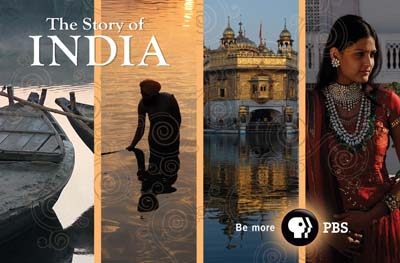
A Look at The Story of India
Co-blogged by Phulkari and Sundari
 Perhaps like many of you, last night was spent watching The Story of India – a BBC series being aired on PBS. The six-part series (which our UK langarites may have already seen as it was aired in the UK in 2007) is narrated by historian Michael Wood and covers 4,500 years of the subcontinent’s rich history.
Perhaps like many of you, last night was spent watching The Story of India – a BBC series being aired on PBS. The six-part series (which our UK langarites may have already seen as it was aired in the UK in 2007) is narrated by historian Michael Wood and covers 4,500 years of the subcontinent’s rich history.
The first two episodes aired last night. Episode One, aptly titled Beginnings, takes us on a journey through India, tracing the incredible richness and diversity of its people, cultures and landscapes. Through ancient manuscripts and oral tales the documentary charts the first human migrations out of Africa.
In Tamil Nadu the latest DNA research takes him to a village where everyone still bears the genetic imprint of those first “beachcombing incomers”-the “first Indians” who went on to populate the rest of the world excluding Africa. [link]
As Wood aptly says, “Mother India indeed”.
Episode Two, The Power of Ideas, shows the age of the Buddha, the coming of the Greeks and the rule of the emperor Ashoka. The documentary takes us on a journey to the ancient cities of the Ganges plain, Northern Iraq, and down the Khyber Pass, thus showing how Alexander the Great’s invasion of India inspired an empire.
In the documentary, Micheal Wood states that the power of India’s history lies in Lahore with the ancient city of Harappa. It is here during it’s high-days between 2,900 BC- 1,900 BC that one of the world’s most complex and organized human society’s developed. At it’s peak, the Harappa population numbered close to 200,000 people.
Wood cites weather, environment, and war as the three main components for creating and destroying civilizations. As the island of India smashed into the Indus River to create the Himalayas, the Harappa civilizations trading community moved into farming as it spread to other parts of the sub-continent. Thus, creating a new juncture in South Asian civilization.
Wood’s journey through South Asia’s history from the Indus Valley to the 21st century shows how India is “always in the making and never made”. His first two episodes are a strong attempt to seek “in the present for clues to her past, and in the past for clues to her future”. He makes clear connections between South Asia’s social, political, economic, and religious layers through picture and sound. Let’s hope the next four episodes are just as good. The last two episodes (i.e. 5 & 6) touch more upon Punjab and Sikhs – you can see a preview of the episode here – and perhaps, like us, you will tune in to see why Wood describes Sikhi as a “radical religion” and why he suggests that the “turban is what all men must wear to enter their holy shrines.” We will post on those two in late January. You will find below a list of all the episodes and air dates.
Lastly, check out the PBS website for the series. It’s a great resource for educators and learners. We were truly impressed by the timeline, which links each period to videos and written summaries. The photo gallery has beautiful pictures.
Let us know what you think of it! TiVo or DVR it … it’s a show you can learn something new from each time you watch it (the first two episodes were packed with tons of rich information).
“The Story Of India” Episodes and PBS Air Dates
EPISODE 1 & 2: Monday, Jan. 5
Beginnings
60,000 BCE–500 BCE
The Power of Ideas
500 BCE–200 BCEEPISODE 3 & 4: Monday, Jan. 12
Spice Routes & Silk Roads
200 BCE–300 CE
Ages of Gold
300 CE–1000 CEEPISODE 5 & 6: Monday Jan. 19
The Meeting of Two Oceans
1000 CE–1700 CE
Freedom
1700 CE –2009 CE














It is very good information in this blog… Good to see more posts like these…..
It is very good information in this blog… Good to see more posts like these…..
It is very good information in this blog… Good to see more posts like these…..
The subtle meaning of Sikh Radical thought was rejection of the Indian society. The radical thought of Sikhi went on to establish the Panth that was contrary to the ideals of the Indian society. This rejection of Indian society is not highlighted by the pseudo-historians and in the above mentioned program also.
The objective of the above mentioned program seems to CONCEAL the experience of Sikhi with the Indian society at large to serve the ulterior purpose of political aggregation of India.
The subtle meaning of Sikh Radical thought was rejection of the Indian society. The radical thought of Sikhi went on to establish the Panth that was contrary to the ideals of the Indian society. This rejection of Indian society is not highlighted by the pseudo-historians and in the above mentioned program also.
The objective of the above mentioned program seems to CONCEAL the experience of Sikhi with the Indian society at large to serve the ulterior purpose of political aggregation of India.
The subtle meaning of Sikh Radical thought was rejection of the Indian society. The radical thought of Sikhi went on to establish the Panth that was contrary to the ideals of the Indian society. This rejection of Indian society is not highlighted by the pseudo-historians and in the above mentioned program also.
The objective of the above mentioned program seems to CONCEAL the experience of Sikhi with the Indian society at large to serve the ulterior purpose of political aggregation of India.
Definitely I would like to share this article with others.Its's really informative.
nice one